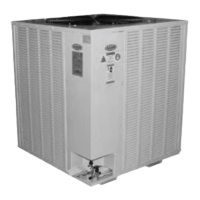Maintenance
(See back of the manual for maintenance
log.)
At least once each year, a qualified service
technician should check out the unit. This
includes reading and recording suction
pressures and checking for normal sub-
cooling and superheat.
Only trained and qualified service
technicians experienced in both condensing
units and air conditioning are permitted to
service the CB Series units to keep
warranties in effect.
Coils
The condenser coils should be inspected
yearly to ensure unrestricted airflow. If the
coils contain a large amount of airborne dust
or other material, they should be cleaned.
Care must be taken to prevent bending of the
aluminum fins on the coils.
Before attempting to clean the coils; set
thermostat to the "OFF" position; turn the
electrical power to the unit to the "OFF"
position at the disconnect switch. The
condenser coil can be cleaned by washing
from the inside out with water and a coil
cleaner. If coil is extremely dirty with
clogged fins, a service professional
specializing in coil cleaning should be
called.
E-Coated Coil Cleaning
Documented routine cleaning of e-coated
coils is required to maintain coating
warranty coverage.
Surface loaded fibers or dirt should be
removed prior to water rinse to prevent
restriction of airflow. If unable to back wash
the side of the coil opposite of the coils
entering air side, then surface loaded fibers
or dirt should be removed with a vacuum
cleaner. If a vacuum cleaner is not available,
a soft non-metallic bristle brush may be
used. In either case, the tool should be
applied in the direction of the fins. Coil
surfaces can be easily damaged (fin edges
bent over) if the tool is applied across the
fins.
Use of a water stream, such as a garden
hose, against a surface loaded coil will drive
the fibers and dirt into the coil. This will
make cleaning efforts more difficult. Surface
loaded fibers must be completely removed
prior to using low velocity clean water rinse.
A monthly clean water rinse is
recommended for coils that are applied in
coastal or industrial environments to help to
remove chlorides, dirt, and debris. It is very
important when rinsing, that water
temperature is less than 130°F and pressure
is than 100 psig to avoid damaging the fin
edges. An elevated water temperature (not to
exceed 130°F) will reduce surface tension,
increasing the ability to remove chlorides
and dirt.
Improper installation, adjustment,
alteration, service or maintenance
can cause property damage,
personal injury or loss of life.
Installation and service must be
performed by a trained, qualified
installer.
Electric shock hazard. Shut off all
electrical power to the unit to avoid
shock hazard or injury from rotating
parts.

